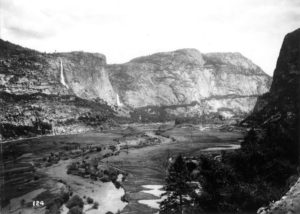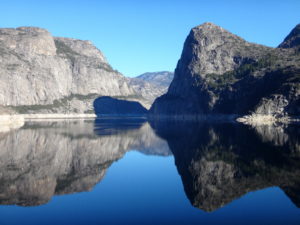It is known as the first major environmental controversy in United States history. It broke John Muir’s heart. To this day, it remains as controversial as when it was built. “It” is the damming of the Hetch Hetchy Valley in Yosemite National Park to provide water and power to San Francisco.
According to John Muir, the Hetch Hetchy Valley was the twin to the world-famous Yosemite Valley. The area was inside the borders of Yosemite National Park, and, therefore, was protected from any exploitation.
Or so it seemed. But San Francisco needed water, and it coveted the clean, clear, reliable supplies from the high Sierras. For many reasons, the Hetch Hetchy Valley of the Tuolumne River was the perfect spot for a dam and reservoir. Others thought it the worst of ideas, as John Muir stated: “Dam Hetch Hetchy! As well dam for water-tanks the people’s cathedrals and churches, for no holier temple has ever been consecrated by the heart of man.”

Forces aligned to protect Yosemite and to exploit it. The battle to dam Hetch Hetchy had reached a stalemate until the 1906 fire destroyed much of San Francisco. The city lacked water supplies to put out the fire. After that disaster, the cause to save Hetch Hetchy was lost. The Raker Act was introduced into Congress to allow two dams to be built in Yosemite; it quickly passed and was signed into law by President Woodrow Wilson on December 19, 1913 (a year later, dispirited by this act and the start of World War I, John Muir died).
Construction on the “Hetch Hetchy System” began soon afterward. The project included two dams and reservoirs inside Yosemite National Park. The first was Lake Eleanor, a relatively small project that produced power that was sold to support the cost of the bigger project in the Hetch Hetchy Valley. The Tuolumne River was impounded by the O’Shaughnessy Dam, completed in May, 1923. Originally 226 feet high, the dam was later raised to the current height of 312 feet. The Dam flooded about nine miles of the river, including the Hetch Hetchy valley.
The main power facility in the system, the Moccasin Powerhouse, began commercial operation on August 14, 1925. Some years later, water began flowing to San Francisco. Since then, the “Hetch Hetchy System” has continued to grow, now including nine impoundments and three powerhouses. The system provides about 75% of the water for San Francisco and surrounding communities, and about 20% of the region’s electricity.

More than 100 years after the dam’s approval, Hetch Hetchy still throbs with controversy. Calls for removing the dam continue, as part of a nationwide trend to remove old and obsolete power dams and restore the submerged ecosystems. Several Secretaries of the Interior, both Republican and Democratic, have floated the idea, but never implemented a process. In 2012, San Franciscans voted on a ballot referendum to study the feasibility of dam removal and alternate water and energy supplies; 77% of voters said no, a resounding defeat. Californians, perhaps more than citizens of any other state, know the value of water and are committed to renewable energy (although some renewable energy advocates reason that hydro-electricity is not greenhouse-gas neutral, that argument loses merit for a nearly century-old dam). Despite the referendum defeat, pro-dam-removal groups have continued to raise legal arguments for removing the O’Shaughnessy Dam.
Dams represent one of the most interesting dilemmas on the route to a sustainable planet. They are massive intrusions onto the landscape, with unavoidable consequences to the local environment (when a landscape is flooded, it changes) and often devastating consequences to people forced to move (although these are political rather than environmental failures). However, dams provide reliable water supplies for irrigation, domestic and industrial uses. They reduce flood damage and generate electricity without burning fossil fuels.
August 14, 1925 saw power first begin to flow from the Hetch Hetchy System, and it has continued to flow unabated since then. And right along with it, the power of environmental controversy has also flowed, equally unabated.
References:
Bolin, Leslie K. 1987. Hetch Hetchy: Facts and Figures. U.C. Davis Environmental Law Society. Available at: https://environs.law.ucdavis.edu/volumes/12/1/bolin.pdf. Accessed June 30, 2018.
Restore Hetch Hetchy. Hetch Hetchy Today. Available at: https://www.hetchhetchy.org/hetch_hetchy_today. Accessed June 30, 2018.
San Franciscon Public Utilities Commission. 2005. A History of the Municipal Water Department & Hetch Hetchy System. Available at: https://sfwater.org/modules/showdocument.aspx?documentid=5224. Accessed June 30, 2018.
Sierra Club California. Hetch hetchy—timeline of the ongoing battle over hetch hetchy. Available at: https://vault.sierraclub.org/ca/hetchhetchy/timeline.asp. Accessed June 30, 2018.
Water Education Foundation. Hetch Hetchy Reservoir and Water System. Available at: https://www.watereducation.org/aquapedia/hetch-hetchy-reservoir-and-water-system. Accessed June 30, 2018.
